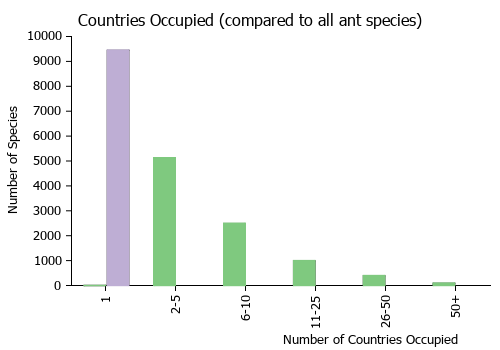Hypoponera mesoponeroides
| Hypoponera mesoponeroides | |
|---|---|
| Scientific classification | |
| Kingdom: | Animalia |
| Phylum: | Arthropoda |
| Class: | Insecta |
| Order: | Hymenoptera |
| Family: | Formicidae |
| Subfamily: | Ponerinae |
| Tribe: | Ponerini |
| Genus: | Hypoponera |
| Species: | H. mesoponeroides |
| Binomial name | |
| Hypoponera mesoponeroides (Radchenko, 1993) | |
This species inhabits secondary and primary forests from the lowland to the highland (up to an approximately 1,000 m alt.), and nests in the leaf litter, soil, rotting logs and rotting wood fragments, and under rocks (Van Dang et al., 2018).
Identification
Distribution
Latitudinal Distribution Pattern
Latitudinal Range: 22.49389° to 20.29472°.
| North Temperate |
North Subtropical |
Tropical | South Subtropical |
South Temperate |
- Source: AntMaps
Distribution based on Regional Taxon Lists
Oriental Region: Vietnam (type locality).
Distribution based on AntMaps
Distribution based on AntWeb specimens
Check data from AntWeb
Countries Occupied
| Number of countries occupied by this species based on AntWiki Regional Taxon Lists. In general, fewer countries occupied indicates a narrower range, while more countries indicates a more widespread species. |

|
Estimated Abundance
| Relative abundance based on number of AntMaps records per species (this species within the purple bar). Fewer records (to the left) indicates a less abundant/encountered species while more records (to the right) indicates more abundant/encountered species. |

|
Biology
Castes
Nomenclature
The following information is derived from Barry Bolton's Online Catalogue of the Ants of the World.
- mesoponeroides. Brachyponera mesoponeroides Radchenko, 1993a: 81, figs. 6, 7 (w.) VIETNAM.
- Type-material: holotype worker, 8 paratype workers.
- Type-locality: holotype Vietnam: Ninh Binh, Cuc-phu’óng, 10.vi.1966, no. 207/66, primary tropical forest, nest in wood stump (R. Bielawski & B. Pisarski); paratypes: 2 workers with same data, 3 workers with same data but no. 199/66, 1 worker with same data but no. 200/66.
- [Note: 8 paratypes are declared but only 6 are accounted for.]
- Type-depository: MIZW.
- Van Dang, Yamane, et al. 2018: 227 (q,).
- Combination in Pachycondyla: Bolton, 1995b: 307;
- combination in Brachyponera: Schmidt, C.A. & Shattuck, 2014: 80;
- combination in Hypoponera: Van Dang, Yamane, et al. 2018: 224.
- Status as species: Bolton, 1995b: 307; Van Dang, Yamane, et al. 2018: 224 (redescription).
- Distribution: Vietnam.
Description
References
- Bolton, B. 1995b. A new general catalogue of the ants of the world. Cambridge, Mass.: Harvard University Press, 504 pp. (page 307, Combination in Pachycondyla)
- Esteves, F.A., Fisher, B.L. 2021. Corrieopone nouragues gen. nov., sp. nov., a new Ponerinae from French Guiana (Hymenoptera, Formicidae). ZooKeys 1074, 83–173 (doi:10.3897/zookeys.1074.75551).
- Radchenko, A. G. 1993a. Ants from Vietnam in the collection of the Institute of Zoology, PAS, Warsaw. I. Pseudomyrmicinae [sic], Dorylinae, Ponerinae. Ann. Zool. (Warsaw) 44: 75-82 (page 81, figs. 6, 7 worker described)
- Schmidt, C.A. & Shattuck, S.O. 2014. The higher classification of the ant subfamily Ponerinae (Hymenoptera: Formicidae), with a review of ponerine ecology and behavior. Zootaxa 3817, 1–242 (doi:10.11646/zootaxa.3817.1.1).
- Van Dang, A., Yamane, S., Nguyen, D.A., Eguchi, K. 2018. New combination and redescription of Brachyponera mesoponeroides Radchenko, 1993 (Hymenoptera: Formicidae: Ponerinae). Revue suisse de Zoologie 125(2): 221-229 (doi:10.5281/zenodo.1414203).
- Yamane, S., Tanaka, H.O., Hasimoto, Y., Ohashi, M., Meleng, P., Itioka, T. 2021. A list of ants from Lambir Hills National Park and its vicinity, with their biological information: Part II. Subfamilies Leptanillinae, Proceratiinae, Amblyoponinae, Ponerinae, Dorylinae, Dolichoderinae, Ectatomminae and Formicinae. Contributions from the Biological Laboratory, Kyoto University 31, 87–157.
References based on Global Ant Biodiversity Informatics
- Ogata K. 2005. Asian ant inventory and international networks. Report on Insect inventory Project in Tropic Asia TAIIV: 145-170.